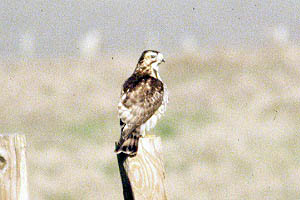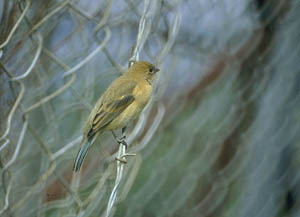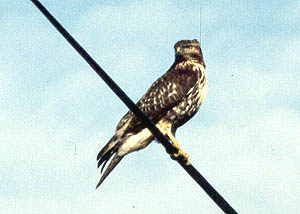March 98 Mystery Birds
I was fascinated by the breadth of opinion on these birds and the lack of consensus on either of them. It became
clear that different viewers were seeing the colors and even the patterns differently on different hardware. I
made several attempts to edit the color balance and contrast on these images with limited success. The original
bunting photos apparently shows more blue on the wing and on the rump than the scanned image (Don DesJardin, pers.
comm.). When I ran the image through my photo editor's "auto level" routine, the resulting image
was a bit paler and much warmer, looking more like Lazuli. I do not have the original slide so I don't know which
version it most closely resembles. The hawk image is too dark; the original slide is definitely much paler above.
More on this below.
My original thoughts were that the bunting was a Lazuli and the hawk was a Broad-wing. However, I can no longer
be absolutely certain, especially in view of expert opinion to the contrary. To jump to the original quiz, click
<here>.
Bunting
This was certainly the most controversial of the two and it generated considerable discussion in the "Frontiers of Bird Identification" mailing
list. Paul Lehman wrote: 98/03/04 mystery bunting
I'd like to thank all these contributors as well as those who added to our public comment
forum. All comments were very thoughtful and some included original, unpublished research. I think this is
the Internet at its best. The diversity of opinion is healthy and highlights the fact that this is an unappreciated
and to some extent, unresolved identification problem.
As this bunting does not seem to fall clearly into either the Indigo or Lazuli category, the possibility that
it might be a Varied Bunting, Passerina versicolor seemed like an attractive alternative. I'd like to thank
Michael Patten for drawing our attention to this generally unappreciated identification problem. In addition to
the difference in wing-pattern and bill-shape mentioned in ID Frontiers commentary, I think the Varied Bunting
can be eliminated by the wing formula visible in the photo. Indigo and Lazuli have longer more pointed wing-tips.
In this photo, I believe the three visible primaries are the 7th, 6th & 5th with the 8th and 9th hidden below
the 7th. The relatively long distance between the 5th and 6th is typical of Indigo/Lazuli. On Varied these two
are much closer together.
Thus the choice is narrowed to Indigo and Lazuli. Extensive support for Indigo on ID Frontiers focused on the
idea that Indigo Buntings can lack visible breast streaks like the bird in this photograph and that the wing pattern
favors Indigo.
I do not disagree, but nevertheless find the arguments in favor of Lazuli more compelling. The vast majority
of Indigo Buntings show clear unambiguous blurry streaks across the breast. If it were an Indigo, it would be one
of a very small percentage that show an unstreaked breast. The tawny, slightly orange cast to the breast also favors
Lazuli in my opinion. Unfortunately the appearance of this and other colors seems to vary when viewed on different
hardware platforms. On my screen, I see fairly strong contrast between an orange-buff band across the breast and
much paler belly and throat area. Most Indigos are more uniformly colored below. Also I think the gray patch on
the rump is real, not an artifact of the light as it is mentioned in Paul Lehman's original notes on this bird.
I think that it is a very strong point in favor of Lazuli. Indigos are more uniform brown on the upperparts, lacking
the contrasting grayish rump typically seen on Lazuli.
The whitish spot on the median coverts mentioned by Matt Heindel and Will Russell is also an important clue
in my opinion. On Lazuli Buntings there is a strong wing-bar formed by the tips to the median coverts and a weaker
one formed by the tips to the greater coverts. These bars are white on adult males and light buff on adult females.
I believe that whitish-buff spot is a molting or displaced feather rather than an anomaly, and that it is representative
of the strong wing-bar expected on Lazuli and absent on Indigo. If the bird were an Indigo, the presence of this
feather would be inexplicable.
The tail shows a pattern of faint dark bars. I interpreted these as growth or stress bars. Their rather even
pattern is suggestive of an immature as growth bars on adults tend to be more irregular. I also think the absence
of any obvious blue or orange on the body suggest it was a female. First winter males normally show more adult-like
feathering after their prebasic molts, although I don't think it is wise to assume unseasonal or out-of-range birds
will necessarily be normal in appearance. The famous pre-basic supplemental molts of immatures are rather eccentric
and I wonder if out of range, or out of season individuals might vary their molt sequence.
Matt Heindel noted that the greater covert fringes include the outer webs on Indigo, but not on Lazuli. specimens.
In my opinion, this is the strongest argument in favor of Indigo. However, I think it would be useful to segregate
specimens by age when comparing wing patterns as there may be a difference in this pattern between immatures and
winter adults. There is definitely a difference between juvenile and adult wing coverts and I think Matt Heindel's
wing pattern observations need further research to see if they apply reliably to all ages.
In view of the divergent opinions of some of North America's leading birders, the possibility of hybridization
needs to be seriously considered. I am aware of at least one report of a female hybrid Indigo x Lazuli Bunting
in California; an adult seen by Rich Stallcup, 13 September 1993 at Point Reyes. I don't know what that bird looked
like or why Rich thought it was a hybrid. I wish I had seen that bird.
In the end it is easier for me to stay with tentative Lazuli or possible hybrid, pending further research. To
identify it as a definite Indigo requires explaining the anomalous combination of unstreaked orange-buff underparts,
contrasting grayish rump, and the apparent whitish tipped median covert.
Hawk
I now believe my orignal analysis was flawed and that the bird was actually an immature
Red-tailed Hawk. At Bill Clark's request I sent the original photo to him for analysis along with a photo of the
second bird also photographed at Valley Ford, Sonoma County, 25 November 1982 by Nancy Conzett.
The second bird is reproduced here. Bill wrote:
"Thanks for sending me the photo of the mystery buteo and the Broad-winged Hawk. There is no doubt that
the one is a juvenile Broad-winged Hawk. The late date is most  interesting. Was the bird seen after that?
interesting. Was the bird seen after that?
"I assume that you might think that the photos are of the same bird. I think not; the other buteo is quite
different. It is overall heavier, with a larger head. Note also the dark area behind the eye, absent on the Broad-winged.
In addition, the flanks are much more heavily marked on the 'mystery' bird and the primaries are not uniform dark
brown, as on the Broad-winged. Further, the wintips reach farther down the tail, compared to the Broad-wing, which
shows them just about half-way down the tail.
"I still feel strongly that this is just a juvenile Red-tail, possibly a light-morph Harlan's. Looking
at the original slide does not change my opinion."
In fact both slides were in my teaching collection for about 15 years and I was content with the identification
the mystery bird as a Red-tail up until I reviewed it several months ago for a class I was teaching on raptors.
In the past I had puzzled over its shape and proportions but felt that the bird just looked too much like a Red-tail
to be anything else. But then I started to have more serious doubts and concluded somewhat reluctantly that it
was a Broad-wing which just happened to look a lot like a Red-tail and I mustered a number of arguments in support
of this reidentification.
I also received correspondence on this bird from Matt Heindel who felt the bird closely resembled a claimed
Broad-winged photographed in Kern County. That bird was studied in life by Matt who concluded it was actually a
Red-tail. Matt's main point is that the underpart pattern is too much like a Red-tail and too unlike a Broad-wing
for it to be the latter. Matt was also concerned that observers might be misled by my photo into believing that
Broad-wings can have an underpart pattern like a Red-tail and that this might result in erroneous claims of Broad-wing.
I agree with his point in general, but felt there were other characters (short wings, number of tail bands, and
apparently dark secondaries and tertials) which favored Broad-wing on the mystery bird.
Looking again at the photo, I now believe that all the tail bands appear to all be the same width. This is correct
for Red-tail and wrong for Broad-wing which has a noticeably broader subterminal band (see above). This combined
with the points made by Bill and Matt have forced me to rethink this bird and I now reluctantly agree that this
bird was a Red-tail.
There is considerable danger in drawing conclusions from a single ambiguous photograph as demonstrated by both
birds in this quiz. But the process of identification is much more interesting to me than the "answer."
I think I learn more by listening to expert discussion where there is disagreement than I do by being told the
answer. In these two cases we may never know for sure what the birds were, but the discussion certainly tought
me a lot. The important thing is we should be open and learn from our mistakes.
Below is the original quiz.
Note: The hawk photo has been enlarged and the color balance adjusted slightly since
I first posted it. These images have up to 35,000 unique colors and are best viewed in "high color" or
"true color" SVGA.
 |
 |
| Don DesJardin contributed this excellent photo of a controversial bunting taken
in Santa Barbara, California in February. Is it Indigo, or Lazuli, or other? Click on the image to view full size.
|
Would you hit the brakes for this hawk photographed in Sonoma County, California in the winter? Is it just
another Red-tail , or something else? Click on image to view full size. |
What do you think? Please click here
to view comments or add your own. Thanks.
 interesting. Was the bird seen after that?
interesting. Was the bird seen after that?
